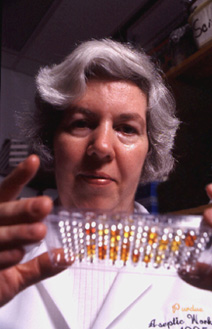 Purdue News
Purdue News
 Purdue News
Purdue News
 At Purdue University, Maribeth Cousin, professor of food microbiology, is working
on a rapid method for detecting molds in raw agricultural commodities. Current tests
take five to 10 days; her method will take less than an hour for commercial users.
At Purdue University, Maribeth Cousin, professor of food microbiology, is working
on a rapid method for detecting molds in raw agricultural commodities. Current tests
take five to 10 days; her method will take less than an hour for commercial users.
"Molds are common contaminants of raw agricultural commodities and foods," Cousin says. "People are wanting foods with less processing, fewer preservatives and a longer shelf life, so mold becomes a concern. But if we detect molds early, we don't have to worry about food spoilage."
Not only are molds responsible for food spoilage, she says, but they also produce mycotoxins, toxic substances that contaminate the foods and cannot be deactivated by processing. According to Cousin, researchers aren't sure of all the risks to humans associated with mycotoxins in foods, but in other countries, continued consumption of high levels of aflatoxin in foods has been implicated in liver cancer. In South Africa and China, fumonisins have been implicated in esophageal cancer after continual consumption of food from corn with high mold levels.
Cousin says such problems are more prevalent in developing countries where people may have no choice but to eat moldy foods.
Currently, food supplies are tested for molds by placing a diluted sample on a plate of agar to allow molds that may be present to grow and show themselves. Because the process takes from five to 10 days, there's ample time for any molds in the original food supply to spread through it and render it inedible.
But, if mold is identified more quickly, she says, steps can be taken to change storage or packaging conditions to halt the mold's growth and prevent destruction of the food or raw commodity.
To test for molds, Cousin is adapting a rapid-detection method that employs the immunological concept of using antibodies to detect antigens. The process is called Enzyme-Linked Immunosorbent Assay, or ELISA.
Antibodies are produced by mammals when a foreign substance -- an antigen -- gets into their blood. In food, a mold produces mold antigens. To test foods for molds using ELISA, a food sample is added to a test kit containing antibodies produced by lab animals. Chemically produced enzymes in the test kit cause a colored reaction if mold is present. The intensity of the color indicates the amount of mold in the food sample.
Food scientists and medical professionals have used ELISA successfully to detect bacteria such as Salmonella , Listeria and E. coli by using antibodies developed to these bacteria. The ELISA method was developed first for the fields of medicine and plant pathology, according to Cousin, and has been adapted to food science more recently. Her lab is one of only three or four in the world working on ELISA for early mold detection.
"We've developed a method," Cousin says. "We know it works. We're just ironing out minor problems.
"One company in Germany is making a test kit to detect Penicillium and Aspergillus in foods. At Purdue, we're working on general mold detection, because many molds grow in foods. We're doing the basic research. Our purpose is not to develop a kit, but to develop research that industry can use to develop test kits."
The ELISA process could save the food industry money in the long run, according to Cousin. At this point, it's hard to say how expensive using ELISA will be, but Cousin says processors must weigh the expense of going to a new system against time saved. Currently, she says, testing involves more people, time and materials than the ELISA process would require.
Cousin points out that mycotoxins aren't the only health threat molds may pose to the food supply.
"ELISA also may be useful for people who have mold allergies and might get the antigens from food," Cousin says.
She explains that most mold allergies occur when people breathe a mold allergen (antigen), but it appears possible that eating an allergen could cause the same symptoms.
Cousin says cereal grains may have molds growing on them in the field. The molds may be killed by food processing, but the antigens they've produced aren't affected and remain in the grain and, subsequently, in the final food product. Bread, snack chips, breakfast cereals, pastas and many other foods -- even beers -- are made from grains.
Source: Maribeth Cousin, (765) 494-8287; Internet, cousinma@foodsci.purdue.edu
Writer: Andrea McCann, (765) 494-8406; Internet, andrea_mccann@aes.purdue.edu
Purdue News Service: (765) 494-2096; e-mail, purduenews@purdue.edu
NOTE TO JOURNALISTS: A color photo of Maribeth Cousin conducting an assay is available from Purdue News Service, (765) 494-2096. Ask for the photo called Cousin/Mold Detection or download here.